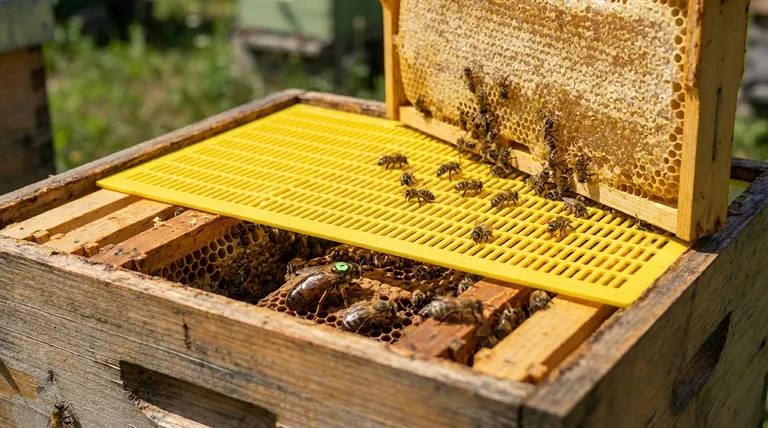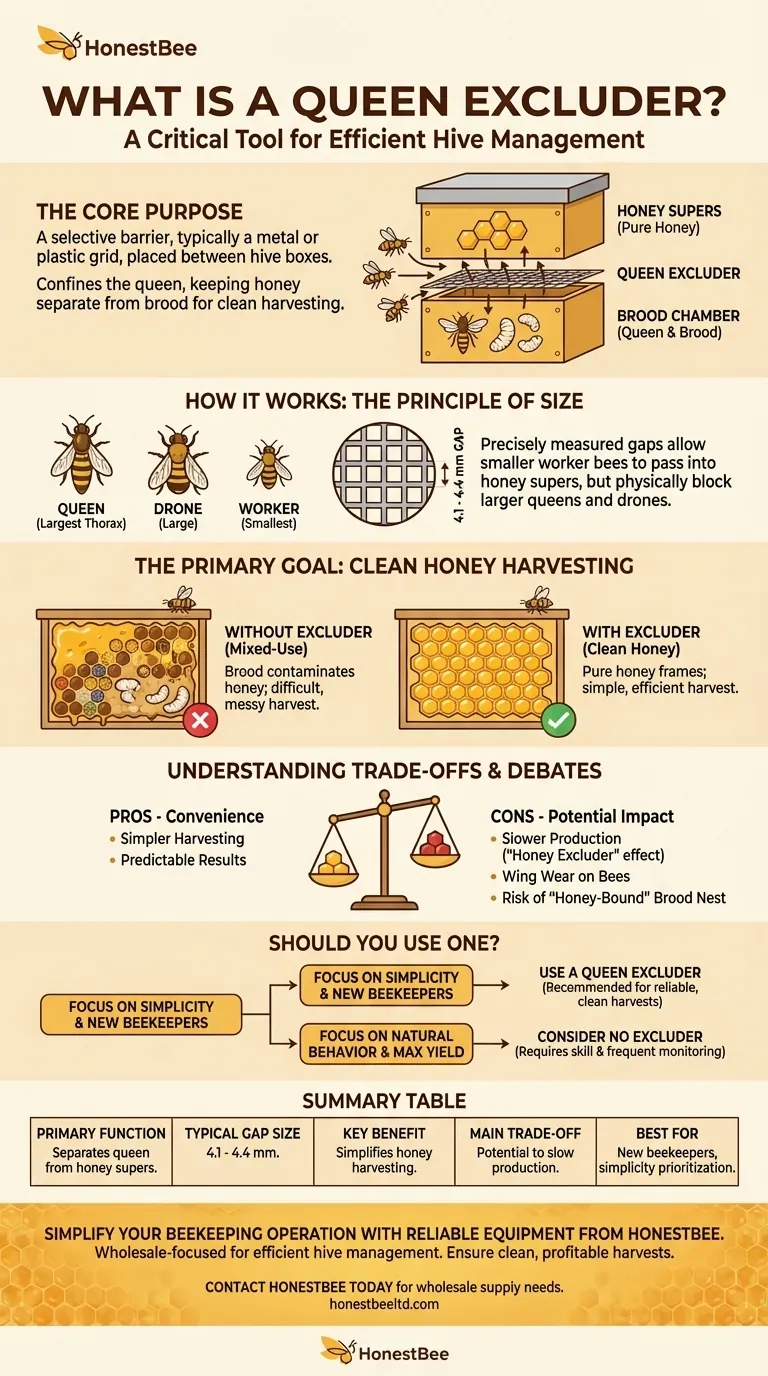In beekeeping, a queen excluder is a simple but critical tool for hive management. It is a selective barrier, typically a flat grid made of metal or plastic, placed between hive boxes. The gaps in the grid are engineered to be large enough for worker bees to pass through but too small for the larger queen bee, effectively confining her to a specific area of the hive. This ensures the queen cannot lay eggs in the sections designated for honey storage.
The core purpose of a queen excluder is to solve a fundamental challenge in beekeeping: keeping honey separate from brood (eggs and larvae). By creating a physical barrier the queen cannot cross, it ensures honey supers contain only honey, which dramatically simplifies the harvesting process.

How a Queen Excluder Works: The Principle of Size
A queen excluder functions by exploiting the simple physical size difference between members of the bee colony. It is a perfect example of purpose-built engineering for hive management.
The Anatomy of the Hive
A honeybee colony has three types of bees, each with a different body size. The queen bee has the largest thorax, which is the middle section of her body. Drones (male bees) are also significantly larger than workers. Worker bees are the smallest adults in the colony.
The Excluder's Precise Design
The excluder is a screen or grid with precisely measured openings. These gaps are typically between 4.1 and 4.4 millimeters wide. This specific dimension is the key to its function.
A Selective Barrier in Action
This precise spacing allows the smaller worker bees to easily squeeze through to access the upper boxes of the hive, known as honey supers. There, they can deposit nectar and build out honeycomb.
However, the queen and the drones, with their larger thoraxes, are physically blocked from passing through the grid. The excluder effectively confines the queen to the lower boxes, called the brood chamber.
The Primary Goal: Clean Honey Harvesting
The reason beekeepers go to the trouble of separating the queen is to ensure a clean and efficient honey harvest. Without an excluder, the hive's internal structure can become disorganized from a human perspective.
The Problem of Mixed-Use Frames
A queen's instinct is to lay eggs in a pattern that expands the colony. Without a barrier, she will readily move into the honey supers and lay eggs in the honeycomb cells. This results in frames containing a mixture of honey, pollen, and brood at various stages of development (eggs, larvae, and pupae).
Why Brood in Honey Is an Issue
Harvesting honey from frames that contain brood is nearly impossible without creating a mess. The process of uncapping wax and spinning frames in a honey extractor would destroy the delicate larvae and contaminate the honey, making it unusable.
The Excluder's Solution
By placing a queen excluder between the brood chamber and the honey supers, the beekeeper dictates the function of each box. The lower boxes are for raising new bees, and the upper boxes are exclusively for storing surplus honey. This creates "clean" frames of pure honey that are simple to harvest.
Understanding the Trade-offs and Debates
While effective, the queen excluder is a topic of debate among beekeepers. Its use involves clear trade-offs between convenience and potential impacts on hive productivity.
Potential for Reduced Honey Production
Some beekeepers refer to the tool as a "honey excluder," arguing that it can slow down honey production. The barrier can create a bottleneck, and some workers may be hesitant to pass through it, potentially reducing the rate at which they store honey in the supers above.
Wear and Tear on Bee Wings
Forcing thousands of bees to repeatedly squeeze through a metal or plastic grid may cause premature fraying and wear on their wings. This can shorten the productive lifespan of forager bees.
The Risk of a "Honey-Bound" Brood Nest
If workers are reluctant to cross the excluder, they may begin storing excess nectar in the brood chamber instead. This can fill cells the queen needs for laying eggs, a condition known as being "honey-bound." This restricts colony growth and can even trigger the hive to swarm.
The Alternative: Natural Management
Many experienced beekeepers choose not to use excluders at all. They rely on the queen's natural tendency to maintain a compact brood nest. By providing ample space and managing the hive carefully, they encourage the bees to naturally store honey in the upper regions of the hive, away from the brood. This method requires more skill and frequent monitoring.
Should You Use a Queen Excluder?
The decision to use a queen excluder depends entirely on your beekeeping goals, philosophy, and experience level.
- If your primary focus is simplicity and a guaranteed clean harvest: Use a queen excluder. It is the most reliable and straightforward method for separating brood from honey.
- If you are a new beekeeper: Starting with a queen excluder is highly recommended. It removes a major variable and makes your first honey harvests significantly easier and more successful.
- If your primary focus is maximizing natural hive behavior and potential yield: Consider beekeeping without an excluder, but be prepared for the more intensive management required to keep the queen in her place.
Ultimately, the queen excluder is a tool that trades a potential, marginal decrease in hive efficiency for a significant increase in management convenience and harvest predictability.
Summary Table:
| Feature | Detail |
|---|---|
| Primary Function | Separates the queen bee from honey supers, keeping brood out of honeycomb. |
| Typical Gap Size | 4.1 - 4.4 mm, allowing worker bees to pass but blocking the queen. |
| Key Benefit | Simplifies honey harvesting by ensuring frames contain only honey. |
| Main Trade-off | Can potentially slow honey production ('honey excluder' effect). |
| Best For | New beekeepers and those prioritizing harvest simplicity and predictability. |
Simplify your beekeeping operation with reliable equipment from HONESTBEE.
Whether you're a commercial apiary or a beekeeping equipment distributor, our wholesale-focused operations provide the durable, purpose-built tools you need for efficient hive management. Ensure clean, profitable honey harvests season after season.
Contact HONESTBEE today to discuss your wholesale supply needs and elevate your beekeeping business.
Visual Guide

Related Products
- Professional Plastic Queen Excluder for Modern Beekeeping
- Wooden Queen Bee Excluder for Beekeeping
- Premium Wood Framed Metal Wire Queen Bee Excluder
- Metal Queen Bee Excluder for Beekeeping
- High Performance Plastic Queen Excluder for Beekeeping and Apiary Management
People Also Ask
- Why are queen excluders recommended for Flow Hives? Prevent Brood Damage for a Clean Harvest
- What is a Queen Excluder and how does it work? Achieve Purer Honey & Better Hive Control
- What are the pros of using a queen excluder? Boost Hive Control & Honey Quality
- How does a queen excluder work? Master Hive Management for Pure Honey Harvests
- What are the main advantages of using a queen excluder in beekeeping? Simplify Hive Management & Harvest



















